
|
Now it is 8.5 mag (July 11, Chris Wyatt). In the Northern Hemisphere, it will be unobservable in August. In the Southern Hemisphere, it is observable in good condition after this.
Date(TT) R.A. (2000) Decl. Delta r Elong. m1 Best Time(A, h)
July 15 14 14.45 -21 7.5 1.106 1.695 105 8.3 20:57 ( 35, 25)
July 22 14 18.17 -25 55.4 1.201 1.721 101 8.5 20:51 ( 36, 19)
|
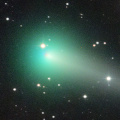
|
Outburst occured on Apr. 4, and it brightened by 2 mag, up to 6.2 mag (Apr. 7, Juan Jose Gonzalez). Now it is fading. But it is bright as 9.6 mag still now (July 5, Chris Wyatt). It stays observable for a long time after this. But it locates low in the Northern Hemisphere. A fragment of 15 mag was detected in mid June.
Date(TT) R.A. (2000) Decl. Delta r Elong. m1 Best Time(A, h)
July 15 2 58.40 21 14.2 1.623 1.494 64 9.3 3:14 (266, 33)
July 22 3 11.71 21 56.7 1.645 1.572 67 9.5 3:21 (268, 38)
|

|
Now it is bright as 10.1 mag (July 2, Juan Jose Gonzalez). It is observable in excellent condition in the Southern Hemisphere. It locates low in the Northern Hemisphere.
Date(TT) R.A. (2000) Decl. Delta r Elong. m1 Best Time(A, h)
July 15 16 36.02 -35 44.7 0.683 1.593 138 10.4 21:03 ( 0, 19)
July 22 16 43.35 -36 29.1 0.722 1.600 133 10.5 20:51 ( 2, 18)
|
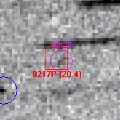
|
Now it is bright as 12.2 mag (July 5, Chris Wyatt). It stays 12 mag until September. In the Southern Hemisphere, it stays at the same altitude in the morning sky. In the Northern Hemisphere, it will be getting higher slowly.
Date(TT) R.A. (2000) Decl. Delta r Elong. m1 Best Time(A, h)
July 15 3 41.55 9 17.5 1.430 1.236 57 12.1 3:14 (271, 18)
July 22 4 7.96 10 12.5 1.431 1.237 57 12.0 3:21 (272, 21)
|

|
Now it is 14.7 mag (July 5, Chris Wyatt). It will brighten up to 12-13 mag and will be observable in good condition in summer.
Date(TT) R.A. (2000) Decl. Delta r Elong. m1 Best Time(A, h)
July 15 23 31.97 14 48.5 2.215 2.760 111 13.0 3:14 (329, 67)
July 22 23 15.62 13 52.8 2.071 2.748 122 12.8 3:18 ( 0, 69)
|

|
Now it is bright as 13.3 mag (July 5, Chris Wyatt).
Date(TT) R.A. (2000) Decl. Delta r Elong. m1 Best Time(A, h)
July 15 21 35.02 -13 28.5 4.923 5.832 150 13.2 2:05 ( 0, 42)
July 22 21 32.28 -13 35.4 4.875 5.830 158 13.2 1:34 ( 0, 41)
|

|
In the Southern Hemisphere, it will be getting higher gradually in the morning sky after this. Then it will be observable at 11 mag for a long time from 2017 autumn to 2018 winter. In the Northern Hemisphere, it will appear in the morning sky in August.
Date(TT) R.A. (2000) Decl. Delta r Elong. m1 Best Time(A, h)
July 15 4 46.46 -5 58.5 4.575 3.999 50 13.3 3:14 (275, -4)
July 22 4 52.74 -5 28.5 4.462 3.949 53 13.2 3:21 (278, 2)
|

|
It has not been observed yet in this apparition. The condition of this apparition is worst. It must have brightened up to 10 mag in spring, but it is not observable at all.
Date(TT) R.A. (2000) Decl. Delta r Elong. m1 Best Time(A, h)
July 15 7 41.81 13 14.9 2.545 1.546 8 13.5 20:57 (128,-24)
July 22 8 1.54 12 6.0 2.606 1.607 8 13.9 3:21 (234,-24)
|

|
Now it is bright as 13.5 mag (July 5, Chris Wyatt). It was expected to brighten up to 12 mag in summer. But actually, it is fainter than expected. It is observable in excellent condition in the Southern Hemisphere. It locates somewhat low in the Northern Hemisphere.
Date(TT) R.A. (2000) Decl. Delta r Elong. m1 Best Time(A, h)
July 15 19 3.78 -30 46.9 1.054 2.059 168 13.9 23:29 ( 0, 24)
July 22 18 58.12 -29 57.0 1.055 2.045 162 13.8 22:56 ( 0, 25)
|
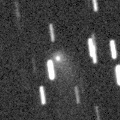
|
Now it is 15.6 mag (June 4, T. Ikemura, H. Sato). In the Northern Hemisphere, it will brighten up to 14 mag from summer to winter, and it will be observable in excellent condition. It is not observable at all after this in the Southern Hemisphere.
Date(TT) R.A. (2000) Decl. Delta r Elong. m1 Best Time(A, h)
July 15 0 42.57 47 36.3 3.223 3.257 82 14.2 3:14 (231, 65)
July 22 0 40.92 50 35.3 3.138 3.245 86 14.1 3:21 (217, 68)
|

|
Now it is 14.1 mag (June 30, Chris Wyatt). It stays 14 mag from spring to summer. It locates somewhat low in the Northern Hemisphere. The perihelion distance increased from 2.4 a.u. to 2.9 a.u. in this apparition. So it will not be bright as before.
Date(TT) R.A. (2000) Decl. Delta r Elong. m1 Best Time(A, h)
July 15 15 42.74 -22 28.1 2.233 2.948 126 14.2 20:57 ( 13, 31)
July 22 15 43.40 -22 43.2 2.305 2.943 119 14.2 20:51 ( 18, 30)
|

|
Now it is 14.7 mag (June 30, Chris Wyatt). It will be observable at 14 mag for a long time from 2017 to 2018.
Date(TT) R.A. (2000) Decl. Delta r Elong. m1 Best Time(A, h)
July 15 17 6.42 23 37.1 3.574 4.200 121 14.4 21:32 ( 0, 79)
July 22 16 55.68 23 41.3 3.622 4.172 116 14.4 20:53 ( 0, 79)
|

|
Now it is 15.7 mag (July 4, J. Gonzalez). It is expected to brighten up to 9 mag in summer in 2018. In the Northern Hemisphere, it stays observable until 2018 summer while the comet will be brightening. In the Southern Hemisphere, it is hardly observable in 2017, but it will be observable in good condition in 2018.
Date(TT) R.A. (2000) Decl. Delta r Elong. m1 Best Time(A, h)
July 15 17 40.22 50 57.7 4.337 4.672 103 14.9 22:05 (180, 74)
July 22 17 31.71 49 37.1 4.292 4.615 102 14.8 21:29 (180, 76)
|

|
Now it is 16.8 mag (July 6, CAO, San Pedro de Atacama). It will brighten up to 15.5 mag in summer. It will be observable in excellent condition in the Southern Hemisphere. It will be getting higher gradually in the morning sky also in the Northern Hemisphere.
Date(TT) R.A. (2000) Decl. Delta r Elong. m1 Best Time(A, h)
July 15 22 0.78 -34 12.0 1.577 2.486 146 15.4 2:30 ( 0, 21)
July 22 21 55.26 -33 1.5 1.542 2.487 152 15.4 1:57 ( 0, 22)
|

|
Now it is 15.6 mag (Mar. 6, Kunihiro Shima). It is appearing in the morning sky. It stays observable at 15.5 mag unil the end of 2017.
Date(TT) R.A. (2000) Decl. Delta r Elong. m1 Best Time(A, h)
July 15 3 17.82 4 49.1 6.070 5.712 64 15.5 3:14 (279, 21)
July 22 3 22.00 4 44.1 5.998 5.737 70 15.5 3:21 (284, 27)
|
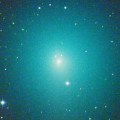
|
It approached to Earth down to 0.14 a.u. from late March to early April, and it brightened up to 6.0 mag (Apr. 7, Juan Jose Gonzalez). Now it is fading. But it is bright as 11.2 mag still now (June 30, Chris Wyatt). It stays observable in good condition after this until the comet fades out.
Date(TT) R.A. (2000) Decl. Delta r Elong. m1 Best Time(A, h)
July 15 18 9.68 -8 58.7 0.602 1.584 155 15.5 22:36 ( 0, 46)
July 22 18 10.20 -11 19.0 0.680 1.644 150 16.3 22:09 ( 0, 44)
|

|
Now it is 15.9 mag (July 5, M. Morales). It is expected to brighten up to 11-12 mag from 2018 to 2019. In the Northern Hemisphere, it stays observable in good condition while the comet will be brightening gradually. In the Southern Hemisphere, it is not observable until 2018 October.
Date(TT) R.A. (2000) Decl. Delta r Elong. m1 Best Time(A, h)
July 15 15 47.30 60 45.5 4.485 4.523 85 15.6 20:57 (168, 63)
July 22 15 34.70 59 59.4 4.481 4.472 82 15.5 20:51 (159, 62)
|

|
First return of a new periodic comet discovered in 2000. Now it is 17.8 mag (June 16, Kunihiro Shima). It will brighten rapidly, and it is expected to be observable at 15.5 mag in good condition from July to September.
Date(TT) R.A. (2000) Decl. Delta r Elong. m1 Best Time(A, h)
July 15 1 4.74 -11 44.0 2.135 2.544 101 15.8 3:14 (318, 33)
July 22 1 9.62 -11 7.1 2.063 2.549 106 15.8 3:21 (325, 37)
|

|
Now it is 16.0 mag (June 16, Kunihiro Shima). It stays observable at 16 mag for a long time from 2017 to 2018. It is getting higher gradually in the morning sky.
Date(TT) R.A. (2000) Decl. Delta r Elong. m1 Best Time(A, h)
July 15 2 45.03 31 8.0 4.792 4.458 64 15.9 3:14 (256, 40)
July 22 2 44.55 30 51.7 4.657 4.442 71 15.8 3:21 (260, 47)
|
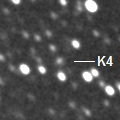
|
Now it is 15.8 mag (June 29, K. Hills). It stays 16 mag for a long time until summer in 2018. In the Southern Hemisphere, it stays observable in excellent condition until autumn. It locates low in the Northern Hemisphere.
Date(TT) R.A. (2000) Decl. Delta r Elong. m1 Best Time(A, h)
July 15 16 44.34 -35 7.6 2.326 3.173 140 15.8 21:11 ( 0, 20)
July 22 16 43.20 -34 18.3 2.349 3.137 133 15.8 20:51 ( 2, 21)
|
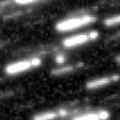
|
Now it is 16.6 mag (June 15, Ken-ichi Kadota). It was observed at 17 mag in 2016. In 2017, it will be observable at 15.5 mag in good condition from summer to autumn.
Date(TT) R.A. (2000) Decl. Delta r Elong. m1 Best Time(A, h)
July 15 1 26.30 10 35.7 2.661 2.825 88 16.0 3:14 (294, 46)
July 22 1 31.49 11 35.6 2.575 2.829 93 15.9 3:21 (300, 52)
|
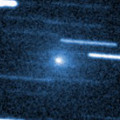
|
It brightened up to 11 mag from March to April. Now it is fading. But it is bright as 12.7 mag still now (May 26, iTelescope Observatory, Siding Spring). In the Southern Hemisphere, it stays observable for a long time, but it stays low. It will be getting higher slowly also in the Northern Hemisphere, but it stays extremely low for a while.
Date(TT) R.A. (2000) Decl. Delta r Elong. m1 Best Time(A, h)
July 15 3 38.51 8 3.8 2.136 1.831 58 16.1 3:14 (273, 18)
July 22 3 48.85 7 56.1 2.155 1.921 63 16.4 3:21 (277, 23)
|
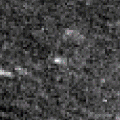
|
Now it is 19.1 mag (June 22, Erwin Schwab, Pablo Ruiz). Return of a new periodic comet which brightened up to 13 mag in 2004. It will be observable in excellent condition in autumn. It is expected to brighten up to 14 mag, if the comet is as bright as when it was discovered.
Date(TT) R.A. (2000) Decl. Delta r Elong. m1 Best Time(A, h)
July 15 1 18.43 -5 51.2 1.498 1.903 96 16.5 3:14 (311, 36)
July 22 1 30.75 -4 53.0 1.415 1.877 99 16.2 3:21 (316, 40)
|
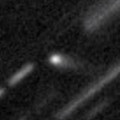
|
Now it is 17.0 mag (May 29, iTelescope Observatory, Siding Spring). It will brighten up to 14.5 mag in winter. In the Southern Hemisphere, it stays observable in excellent condition until spring in 2018. In the Northern Hemisphere, it stays unobservable until 2018.
Date(TT) R.A. (2000) Decl. Delta r Elong. m1 Best Time(A, h)
July 15 0 53.66 -69 21.2 2.273 2.841 113 16.3 3:14 (349,-17)
July 22 1 14.76 -71 9.4 2.225 2.787 113 16.2 3:21 (351,-18)
|

|
Now it is 16.1 mag (June 25, Catalina Sky Survey). It stays 16 mag from 2016 to 2017. In the Northern Hemisphere, it stays observable in good condition for a long time. In the Southern Hemisphere, it will never be observable again.
Date(TT) R.A. (2000) Decl. Delta r Elong. m1 Best Time(A, h)
July 15 18 13.84 66 3.7 6.320 6.418 90 16.4 22:38 (180, 59)
July 22 18 7.39 66 7.2 6.336 6.429 90 16.4 22:05 (180, 59)
|

|
It brightened up to 11 mag from spring to summer in 2016. Now it is 16.3 mag (June 1, Alexander Baransky). It stays observable for a long time after this, but it will be fainter than 18 mag in October.
Date(TT) R.A. (2000) Decl. Delta r Elong. m1 Best Time(A, h)
July 15 20 3.74 -18 50.9 2.312 3.323 173 16.5 0:34 ( 0, 36)
July 22 19 57.42 -19 13.9 2.344 3.359 177 16.6 0:00 ( 0, 36)
|

|
Hilda-type minor planet, but the cometary activity was detected on July 3. Now it is bright as 16.5 mag (July 3, G. J. Leonard).
Date(TT) R.A. (2000) Decl. Delta r Elong. m1 Best Time(A, h)
July 15 21 23.90 3 51.0 2.430 3.303 143 16.6 1:53 ( 0, 59)
July 22 21 20.28 3 36.6 2.402 3.319 149 16.6 1:22 ( 0, 59)
|

|
It brightened up to 11.5 mag from late March to early April (Mar. 24, Andrew Pearce). Now it is fading. It has already faded down to 17.8 mag (June 30, CAO, San Pedro de Atacama). Bright 12-mag new fragment BT was discovered on Feb. 10, but now it is faint as 18.9 mag (June 2, CAO, San Pedro de Atacama). In the Southern Hemisphere, it stays observable for a long time after this. It is getting observable in the morning sky again also in the Northern Hemisphere.
Date(TT) R.A. (2000) Decl. Delta r Elong. m1 Best Time(A, h)
July 15 2 44.78 5 43.6 1.857 1.824 72 16.7 3:14 (283, 28)
July 22 2 53.03 6 11.3 1.842 1.887 76 16.9 3:21 (287, 33)
|
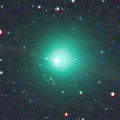
|
Now it is fading rapidly. It has already faded down to 16.9 mag (June 2, T. Ikemura, H. Sato). In the Southern Hemisphere, it stays observable in good condition after this while the comet will be fading. It locates low in the Northern Hemisphere.
Date(TT) R.A. (2000) Decl. Delta r Elong. m1 Best Time(A, h)
July 15 21 48.29 -23 38.9 1.157 2.099 149 16.9 2:18 ( 0, 31)
July 22 21 31.73 -24 37.0 1.189 2.170 159 16.9 1:34 ( 0, 30)
|

|
Now it is 19.7 mag (Apr. 27, iTelescope Observatory, Siding Spring). It will pass the perihelion on Oct. 27. In the Southern Hemisphere, it stays observable while the comet will be brightening, until early October when the comet will brighten up to 9 mag. In the Northern Hemisphere, it is not observable at all in this apparition.
Date(TT) R.A. (2000) Decl. Delta r Elong. m1 Best Time(A, h)
July 15 22 16.76 -70 11.2 1.361 2.124 125 17.3 2:47 ( 0,-15)
July 22 21 51.42 -74 49.9 1.285 2.033 123 16.9 1:55 ( 0,-20)
|

|
Now it is 18.4 mag (May 31, iTelescope Observatory, Siding Spring). It will brighten rapidly, up to 15 mag in autumn, and will be observable in good condition in the Northern Hemisphere. It locates low in the Southern Hemisphere.
Date(TT) R.A. (2000) Decl. Delta r Elong. m1 Best Time(A, h)
July 15 2 50.11 14 8.2 2.089 1.954 68 17.2 3:14 (275, 31)
July 22 3 4.77 15 43.6 2.018 1.941 70 17.0 3:21 (276, 36)
|

|
Now it is 17.6 mag (June 30, ATLAS-MLO, Mauna Loa). It brightens up to 16.5-17 mag in August, and it will be observable in good condition.
Date(TT) R.A. (2000) Decl. Delta r Elong. m1 Best Time(A, h)
July 15 15 19.93 -23 5.9 0.360 1.241 121 17.3 20:57 ( 18, 30)
July 22 15 40.89 -16 42.1 0.362 1.226 117 17.1 20:51 ( 21, 36)
|

|
Now it is 16.7 mag (June 27, Hidetaka Sato). It will fade out after this, and it will be fainter than 18 mag in August.
Date(TT) R.A. (2000) Decl. Delta r Elong. m1 Best Time(A, h)
July 15 17 51.31 27 34.3 3.159 3.828 124 17.2 22:17 ( 0, 83)
July 22 17 48.22 27 35.0 3.231 3.864 121 17.3 21:46 ( 0, 83)
|

|
Now it is 17.2 mag (June 26, D. Briggs). It is expected to brighten up to 13-14 mag from 2018 to 2019. In the Northern Hemisphere, it stays observable in good condition for a long time. In the Southern Hemisphere, it is not observable until summer in 2018.
Date(TT) R.A. (2000) Decl. Delta r Elong. m1 Best Time(A, h)
July 15 20 51.72 70 38.1 5.863 5.896 86 17.5 1:21 (180, 54)
July 22 20 33.24 70 42.1 5.780 5.848 88 17.5 0:35 (180, 54)
|
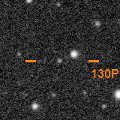
|
Now it is 17.9 mag (May 27, T. Ikemura, H. Sato). It will be brightening slowly until autumn when it becomes 16.5-17 mag. It will be getting lower gradually in the Northern Hemisphere.
Date(TT) R.A. (2000) Decl. Delta r Elong. m1 Best Time(A, h)
July 15 14 16.52 -12 18.7 1.942 2.394 103 17.6 20:57 ( 40, 33)
July 22 14 20.54 -12 58.0 1.995 2.361 97 17.5 20:51 ( 44, 30)
|

|
Now it is 17.4 mag (June 16, Kunihiro Shima). It stays 15 mag from 2018 to 2019, and it will be observable for a long time in the Southern Hemisphere. In the Northern Hemisphere, it will never be observable again. It will be unobservable temporarily from September to October also in the Southern Hemisphere.
Date(TT) R.A. (2000) Decl. Delta r Elong. m1 Best Time(A, h)
July 15 11 59.94 -26 39.5 6.221 6.124 79 17.5 20:57 ( 56, 1)
July 22 12 2.02 -26 51.1 6.279 6.082 74 17.5 20:51 ( 58, -2)
|

|
Now it is 17.9 mag (June 2, MASTER-OAFA Observatory). It will brighten up to 14 mag from autumn to winter in 2018, and it will be observable in excellent condition in the Northern Hemisphere. In 2017, it is observable at 17 mag in excellent condition in the Southern Hemisphere.
Date(TT) R.A. (2000) Decl. Delta r Elong. m1 Best Time(A, h)
July 15 0 28.34 -41 34.4 3.823 4.375 116 17.6 3:14 (341, 10)
July 22 0 27.84 -42 14.5 3.719 4.334 121 17.5 3:21 (347, 11)
|

|
Now it is 17.5 mag (June 30, ATLAS-MLO, Mauna Loa). It is observable in good condition in the Southern Hemisphere. It stays extremely low in the Northern Hemisphere.
Date(TT) R.A. (2000) Decl. Delta r Elong. m1 Best Time(A, h)
July 15 12 48.57 -28 10.4 5.835 5.924 90 17.6 20:57 ( 47, 8)
July 22 12 51.92 -27 23.1 5.943 5.927 84 17.6 20:51 ( 51, 6)
|

|
It stayed bright 12 mag for a long time from autum in 2015 to summer in 2016. Now it is fading. It has already faded dwon to 17.9 mag (July 3, ATLAS-HKO, Haleakala).
Date(TT) R.A. (2000) Decl. Delta r Elong. m1 Best Time(A, h)
July 15 15 59.17 -15 58.8 4.745 5.434 128 17.7 20:57 ( 10, 38)
July 22 15 56.07 -16 31.6 4.892 5.487 121 17.8 20:51 ( 17, 37)
|
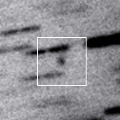
|
Now it is 18.3 mag (June 20, P. Camilleri, H. Williams). It stays observable at 18 mag from spring to summer. It is observable in excellent condition in the Southern Hemisphere. In the Northern Hemisphere, it stays low for a while.
Date(TT) R.A. (2000) Decl. Delta r Elong. m1 Best Time(A, h)
July 15 22 27.06 -34 11.6 4.664 5.489 140 17.7 2:56 ( 0, 21)
July 22 22 24.21 -34 15.3 4.637 5.511 146 17.7 2:26 ( 0, 21)
|
|
![]()
 213P/Van Ness
213P/Van Ness C/2016 N4 ( MASTER )
C/2016 N4 ( MASTER ) 65P/Gunn
65P/Gunn C/2015 O1 ( PanSTARRS )
C/2015 O1 ( PanSTARRS ) C/2016 M1 ( PanSTARRS )
C/2016 M1 ( PanSTARRS ) C/2017 D2 ( Barros )
C/2017 D2 ( Barros ) C/2011 KP36 ( Spacewatch )
C/2011 KP36 ( Spacewatch ) 41P/Tuttle-Giacobini-Kresak
41P/Tuttle-Giacobini-Kresak C/2016 N6 ( PanSTARRS )
C/2016 N6 ( PanSTARRS ) 352P/2017 L1 ( Skiff )
352P/2017 L1 ( Skiff ) C/2015 V1 ( PanSTARRS )
C/2015 V1 ( PanSTARRS ) C/2017 K4 ( ATLAS )
C/2017 K4 ( ATLAS ) 47P/Ashbrook-Jackson
47P/Ashbrook-Jackson C/2017 E1 ( Borisov )
C/2017 E1 ( Borisov ) P/2017 M2 ( LINEAR-NEAT )
P/2017 M2 ( LINEAR-NEAT ) C/2017 K6 ( Jacques )
C/2017 K6 ( Jacques ) C/2014 OE4 ( PanSTARRS )
C/2014 OE4 ( PanSTARRS ) 81P/Wild 2
81P/Wild 2 (457175) 2008 GO98
(457175) 2008 GO98 73P/Schwassmann-Wachmann 3
73P/Schwassmann-Wachmann 3 2P/Encke
2P/Encke 96P/Machholz 1
96P/Machholz 1 145P/Shoemaker-Levy 5
145P/Shoemaker-Levy 5 189P/NEAT
189P/NEAT C/2016 B1 ( NEOWISE )
C/2016 B1 ( NEOWISE ) C/2017 M4 ( ATLAS )
C/2017 M4 ( ATLAS ) 130P/McNaught-Hughes
130P/McNaught-Hughes C/2017 B3 ( LINEAR )
C/2017 B3 ( LINEAR ) (944) Hidalgo
(944) Hidalgo C/2017 E3 ( PanSTARRS )
C/2017 E3 ( PanSTARRS ) C/2014 W2 ( PanSTARRS )
C/2014 W2 ( PanSTARRS ) C/2015 H2 ( PanSTARRS )
C/2015 H2 ( PanSTARRS )![]()


































